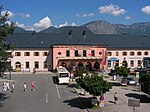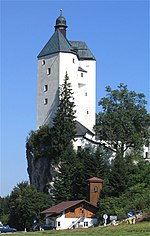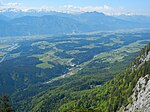Salzburg-Tyrol Railway
1873 establishments in AustriaKitzbühel DistrictKufstein DistrictRailway lines in Austria

The Salzburg-Tyrol Railway (German: Salzburg-Tiroler-Bahn) is a main line railway in Austria. It runs through the states of Salzburg and Tyrol (North Tyrol) from the city of Salzburg to Wörgl and belongs to the core network (Kernnetz) of the Austrian Federal Railways (ÖBB). The section between Salzburg and Schwarzach-Sankt Veit is part of the Salzburg S-Bahn urban railway network.
Excerpt from the Wikipedia article Salzburg-Tyrol Railway (License: CC BY-SA 3.0, Authors, Images).Salzburg-Tyrol Railway
Bahnhofplatz,
Geographical coordinates (GPS) Address Nearby Places Show on map
Geographical coordinates (GPS)
| Latitude | Longitude |
|---|---|
| N 47.491666666667 ° | E 12.061111111111 ° |
Address
Wörgl Hbf
Bahnhofplatz
6300
Tyrol, Austria
Open on Google Maps








